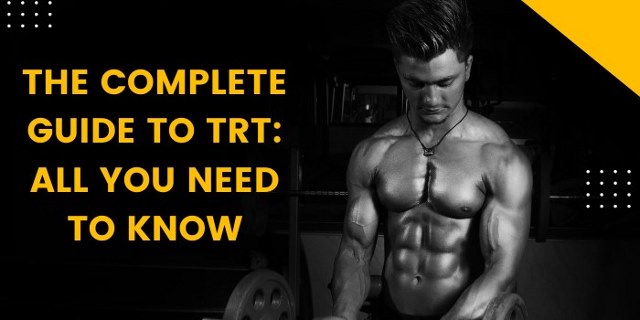Testosterone is of major concern to most men who are aware and sensitive of their health and general well-being. Like other hormones, testosterone plays a critical development role in males and females. Even later in life, it influences several biological functions.
Testosterone is a hormone that affects men’s health in many ways. It helps maintain muscle mass and bone density, regulate mood, improve memory, and increase libido. Unfortunately, studies show that testosterone levels in men begin to reduce with age.
Recent research demonstrated that exercise could increase the quality of testosterone in men. In addition, it has been found that physically active men have a greater chance to increase their testosterone levels. However, some cases require Testosterone Replacement Therapy (TRT) to help with low testosterone levels.
This guide explains everything you should know about TRT to make the most of it.
What is TRT?
Testosterone replacement therapy (TRT) is a medical treatment that helps manage low testosterone levels in men. TRT can be prescribed by doctors or administered by non-medical personnel such as fitness trainers or massage therapists. It is often used by older men with low testosterone due to aging or certain medical conditions, like chronic kidney disease and cancer. It’s also valuable when combined with other treatments such as estrogen therapy and medications that reduce blood sugar levels.
The most common conditions treated with testosterone replacement therapy are male hypogonadism and delayed puberty. Testosterone replacement therapy has existed for several decades, but it was not until recently that the use of testosterone became more widespread among patients. The reason for this recent surge in popularity of the treatment stems from the fact that patients currently have more alternatives at their disposal than before, including oral medications and injections. This also explains why there are more options if you’re wondering where to get T400 steroids in Canada.
How TRT Works?
You’re undoubtedly interested in how TRT works now that we’ve unanswered the question of “What is TRT?”
TRT, in a nutshell, is an FDA-approved method of supplying your body with the testosterone it requires to operate correctly. It’s common knowledge that testosterone is the most common androgen in men and women (although in smaller quantities). It affects various biological processes that are essential for good health and lifespan.
Low testosterone, for instance, is linked to a higher risk of cardiovascular disease, type 2 diabetes, and many other health issues. That’s because testosterone is a potent anabolic hormone that directly affects muscle protein synthesis. Low testosterone levels render it far more challenging to gain and retain muscular growth.
Consequently, using testosterone 400 induces the body to bring testosterone levels within a healthy range, resulting in the reversal of low testosterone. On the other hand, TRT isn’t an immediate fix; some users will not notice any positive results for another one to two months.
Benefits of TRT
Individuals with low T can derive numerous benefits from TRT. First, it’s about allowing enough time for testosterone balance to restore. But for those just getting started, it’s vital to avoid getting ahead of yourself since you won’t notice significant changes immediately. However, this does ‘t mean you won’t see any short-term results.
Below are the various short-term and long-term benefits TRT can bring you.
Short-term Benefits of TRT
- Improved erectile quality
- Increased sex drive/libido
- Higher motivation, vitality, and confidence
- A rise in cognitive function and energy level
- Bette sleep quality
- More appetite
Benefits to Expect After a Few Months
- Stronger immune system
- Improved joint and bone health
- Faster post-workout recovery
- Enhanced muscle growth
- Boost in production of red blood cells
- Increased facial hair growth
Possible Risks Associated With TRT
After prolonged usage, testosterone, like any prescription medicine, can have specific adverse effects. Because the purpose of TRT is to preserve testosterone levels in a safe range, the side effects are thankfully minimal. Your doctor should alter your testosterone dose if your testosterone levels get too high while on TRT.
Some believe that testosterone causes significant negative effects and “roid fury,” which is not the case when administered in tiny doses (as is the case on TRT). Intuitively, if you take a lot of testosterone (for example, for physical performance improvement), you’re more likely to experience negative side effects like high blood pressure, infertility, and gynecomastia.
TRT, on the other hand, carries minor side effects. After being on TRT for a while, some men may notice oily skin, body hair development (back and chest), and testicular atrophy. In most instances, these side effects are treatable and may even disappear as the body changes to accommodate TRT.
There are, thankfully, ways to avoid severe TRT adverse effects. For example, acne and excessive body hair development are manageable by regular showers, grooming, and various topical skincare treatments. TRT can also be supplemented with human chorionic gonadotropin (HCG), a luteinizing hormone analog, to preserve fertility and testicular growth.
However, speak with your doctor before modifying your TRT program or drugs.
What to Expect After Stopping TRT?
It’s difficult to predict how you’ll feel if you decide to quit testosterone replacement medication. Every man who completes his treatment will have different side effects, especially if done incorrectly.
In some situations, stopping TRT will cause your body to revert to its earlier state. Most patients report feeling exhausted, weaker, losing muscle mass, gaining weight, receding hair, and having less sexual desire.
Unlike the positive effects of TRT, which take time to manifest after starting the therapy, the sensations and symptoms connected with stopping it manifest far more quickly. However, a return to their pre-treatment state may be preferable to adverse effects for some people. It all boils down to personal preference and what you and your doctor choose to be the best course of action for you.
Conclusion
Finally, testosterone replacement therapy is a viable option for people with low levels of the natural male hormone. However, it’s vital to understand the possible side effects and risks associated with this treatment. For several years since its initial introduction, TRT has become popular among men for diverse reasons, with some even using it to help enhance physical and athletic performance. Nevertheless, it’s not for everyone, and not all men are eligible to receive this treatment. Preferably, you need to speak to a qualified healthcare professional before starting TRT.
References
https://www.nih.gov/news-events/nih-research-matters/understanding-how-testosterone-affects-men
https://www.ncbi.nlm.nih.gov/pmc/articles/PMC2544367/
https://www.ncbi.nlm.nih.gov/pmc/articles/PMC3255409/
https://www.aafp.org/afp/2017/1001/p441.html#afp20171001p441-b1
https://www.fda.gov/Drugs/DrugSafety/ucm436259.htm
https://www.ncbi.nlm.nih.gov/pmc/articles/PMC4212439/





